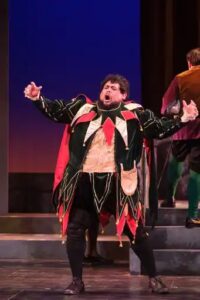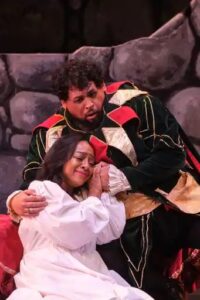
Rigoletto – Courtesy of Denis Ryan Kelley, Jr. Used with permission.

Rigoletto – Courtesy of Denis Ryan Kelley, Jr. Used with permission.
How sublime it felt to experience one of Giuseppe Verdi’s most enduring masterpieces, Rigoletto, presented by the Indianapolis Opera, on Saturday at Booth Tarkington Civic Theatre at the Allied Center for the Performing Arts in Carmel.
The beloved opera, which was a hit following its premiere in Venice in 1851 recounts the tragic story of the lascivious Duke of Mantua, his hunch-backed court jester Rigoletto, and Rigoletto’s daughter Gilda. The opera’s original title, La Maledizione (The Curse), refers to a curse placed on both the Duke and Rigoletto by the enraged Count Monterone, whose daughter the Duke has seduced through Rigoletto’s complicity. The curse comes to realization when innocent Gilda falls in love with the rakish Duke and sacrifices her life to save him from the assassin hired by her father.
Directed by Mark Freiman, the three act opera, with its themes of seduction, mistaken identity and the consequences of love gone wrong, included two intermissions and lasted three hours. It featured a mix of seasoned singers and those who are still young in their careers.
Standing out was baritone extraordinaire Jose Luis Maldonado. He turned in a compelling and bigger-than-life vocal and dramatic performance in the title role, as the cruel buffoon turned aggrieved, loving father.

Rigoletto – Courtesy of Denis Ryan Kelley, Jr. Used with permission.
Also making her substantial presence known was coloratura soprano Brandi Inez Sutton as the pure but deeply flawed and vulnerable Gilda. Her vocal technique was flawless, and her acting equally impressive. Sutton’s breathtaking performance of the famous Cara Nome aria was nothing short of spectacular.
Commanding in smaller roles were baritone Daniel Narducci as Count Monterone and bass Peter Volpe as Sparafucile. With both projecting dynamic stage presence they also displayed refined vocal instruments that reflected years’ worth of training and experience.
Showing career promise was tenor Ganson Salmon as the Duke of Mantua. Though his rendition of La Donna e Mobile was appealing, his projection, especially in Act 1, was short in volume. Plus, his understated characterization of the caddish Duke lacked energy and swagger.
The orchestra, led expertly by IO principal conductor Alfred Savia was superb in its interpretation of Verdi’s exquisite score, and the chorus singes vocals under master Dr. Cara Showing were masterful. Unfortunately. the manner in which the singers were blocked, requiring them to stand in shoulder to shoulder, static lines across the stage rather than in groupings in some scenes, revealed staging that lacked variety and imagination.
The production itself benefited from the Tarkington facility, which possesses all the bells and whistles that gave Rogoletto the technical polish it deserved. Especially effective was Greg Cox’s stunning lighting design. Less so were the production’s pedestrian sets and costumes. Overall, though the production had its flaws and shortcomings, the stellar quality of most of its performances and Verdi’s arresting music made its flaws easy to overlook.




